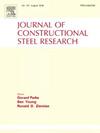Assessing the effects of long-term temperature fields on the performance of a metal roof system with measured temperature field distributions
IF 4
2区 工程技术
Q1 CONSTRUCTION & BUILDING TECHNOLOGY
引用次数: 0
Abstract
The thermal effects, which include temperature distribution characteristics, of metal roof systems are remarkable under solar radiation. Understanding the temperature distribution of a roof system is the premise of analysing its temperature effect. To obtain the temperature distribution of a continuously welded stainless steel roof (CWSSR) system, in this work, an experimental study was carried out on the temperature changes at different positions on the surface of a stainless steel roof panel. The thermal effect of the roof system is analysed via experiments and numerical analysis under different thermal loadings. The effects of static and cyclic temperatures on the mechanical properties of the roof system are considered. The temperature distribution measurements revealed that the temperature field of the CWSSR system was nonuniform over time, but it was approximately uniform along the dimensions of the sample. When the temperature increases by 1 °C, the maximum stress and displacement increase by 2.25 MPa and 0.02 mm, respectively. The comparative analysis reveals that the experimental results are similar to the numerical results, and the maximum error is 8.2 %. Long-term cycle thermal loading can reduce the mechanical properties of key connection nodes, and the maximum reduction rate was 6.1 %. The temperature significantly influences the mechanical properties of the roof system. The analysis of the bearing performance and service life of the CWSSR system should consider not only the wind load but also the influence of the cyclic temperature effect.
求助全文
约1分钟内获得全文
求助全文
来源期刊

Journal of Constructional Steel Research
工程技术-工程:土木
CiteScore
7.90
自引率
19.50%
发文量
550
审稿时长
46 days
期刊介绍:
The Journal of Constructional Steel Research provides an international forum for the presentation and discussion of the latest developments in structural steel research and their applications. It is aimed not only at researchers but also at those likely to be most affected by research results, i.e. designers and fabricators. Original papers of a high standard dealing with all aspects of steel research including theoretical and experimental research on elements, assemblages, connection and material properties are considered for publication.
 求助内容:
求助内容: 应助结果提醒方式:
应助结果提醒方式:


